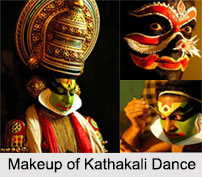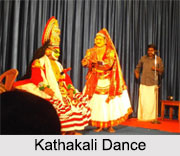 Costumes and Make Up in Kathakali conserve its masculine aspect in its essential vigour. Strong ‘Malayan’ and ‘Tibetan’ influences are recognized in the decorations of the actors. ‘Kathakali’ Dance form is noted for its ancient costumes and grand headgears. The costumes used are heavy, intricate, elaborate and colourful. They transform the actor mentally and physically to portray a particular character. The costume is the most characteristic feature of ‘Kathakali’ Dance. The beautiful costumes of the ‘Kathakali’ dancers are the essence of the entire performance.
Costumes and Make Up in Kathakali conserve its masculine aspect in its essential vigour. Strong ‘Malayan’ and ‘Tibetan’ influences are recognized in the decorations of the actors. ‘Kathakali’ Dance form is noted for its ancient costumes and grand headgears. The costumes used are heavy, intricate, elaborate and colourful. They transform the actor mentally and physically to portray a particular character. The costume is the most characteristic feature of ‘Kathakali’ Dance. The beautiful costumes of the ‘Kathakali’ dancers are the essence of the entire performance.Costumes in Kathakali
There are numerous kinds of costume in ‘Kathakali’ Dance. These are: ‘Sathwika’ (the hero), ‘Kathi’ (the villain), ‘Minukku’ (females) and ‘Thatti’. These essential divisions are subdivided in a way which is very famous to ‘Malayali’ (Keralite) audiences. Each character is right away recognisable by their characteristic makeup and costume. The ‘Sathwika’ characters or the hero put on diverse attires as compared to the evil characters. The ‘Pachcha’ characters generally dress in a jacket of purple, blue or yellow colour. The red-beards wear a red jacket and the white-beards wear a white jacket.
The lower half of the costume of ‘Kathakali’ dancer is general including the ‘minukku’ characters. An effort is made to broaden the actor’s parts by using greatly plaited skirts. Under this amazing make-up, a colossal headgear and fantastic costume is elastic, flexible, thin and well-trained. Most male characters dress in dark complete-sleeved jackets with coloured or white rounded long skirts. Lengths of white cloth thrown over the shoulders are also there. The female characters tie a knot on the top of their hair and the ornamented scarf is falling over red jackets coupled with a white saree covering the lower half of the body.
Ornaments in Kathakali
 The ornaments and jewelleries consist of necklace, bracelets, bangles, gilt breast-plates and bunches of small bells strung round the ankles. ‘Kathakali’ Dance is the decoration of the eyebrows, eyelids, the eyeballs, the iris and the pupil to the highest degree for eye expression. In this style of dance, the presentation of the eyes of all the characters is blushed by the application of gentle nuisance of a flower to give prominence to the eyes. The bright red eyes suit better to the various moods of the characters and. The red eyes together are decorated brilliantly and colourful make-ups, head-dresses, beautiful costumes and jewellery give on ‘Kathakali’ dance an extraordinary feature which changes the whole dance-drama.
The ornaments and jewelleries consist of necklace, bracelets, bangles, gilt breast-plates and bunches of small bells strung round the ankles. ‘Kathakali’ Dance is the decoration of the eyebrows, eyelids, the eyeballs, the iris and the pupil to the highest degree for eye expression. In this style of dance, the presentation of the eyes of all the characters is blushed by the application of gentle nuisance of a flower to give prominence to the eyes. The bright red eyes suit better to the various moods of the characters and. The red eyes together are decorated brilliantly and colourful make-ups, head-dresses, beautiful costumes and jewellery give on ‘Kathakali’ dance an extraordinary feature which changes the whole dance-drama.The name of the different ornaments and jewelleries which are used in ‘Kathakali’ Dance are - ‘Tholpoottu’, ‘Thoda’, ‘Valla’, ‘Chamaram’, ‘Chevipoovu’, ‘Hasthakhadakam’, ‘Padiyaranjanam’, ‘Pattuval’, ‘Parithikkamini’, ‘Santham-Peace’, ‘Kachamani’, ‘Chuttithuni’, ‘Kazhuthu Nada/Netti Nada’, ‘Marmala’, ‘Kurunira’, ‘Keshabharam/Kireedam’, ‘Kuttichamaram’, ‘Hanumanmudi’, ‘Krishnamudi’, ‘Konda’, ‘Makudamudi’, ‘Kaattalan’, ‘Kazhutharam’, etc.
For more, visit the link below: